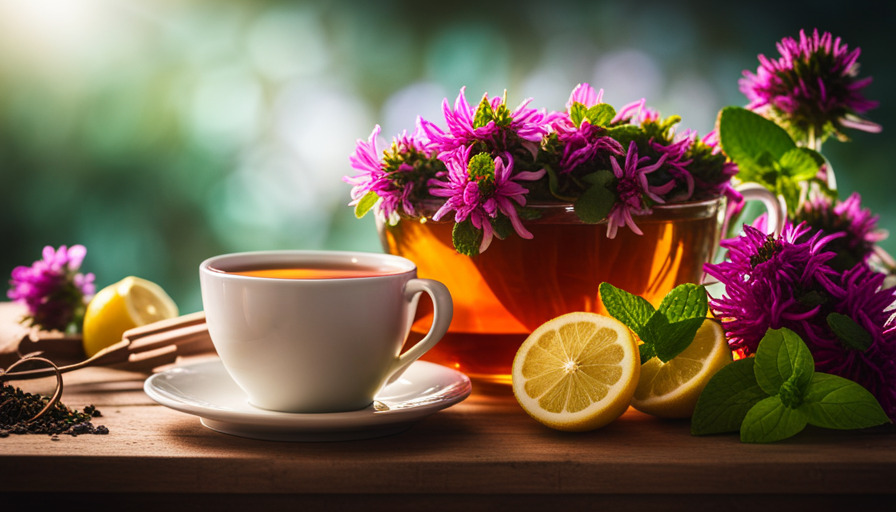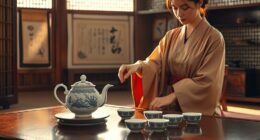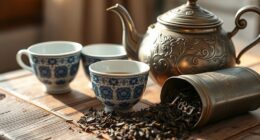Get ready to be blown away by the stunning beauty and incredible health benefits of hibiscus flowers! As a lover of tea, I can confidently say that hibiscus flower tea is a true marvel. Its vibrant colors and exotic appearance make it a feast for the eyes, while its countless therapeutic properties make it a powerhouse for your health.
Prepare to indulge in a delicious cup of hibiscus tea that not only tantalizes your taste buds but also works wonders for your body. Packed with antioxidants, this tea helps fight off free radicals and supports overall well-being.
But that’s not all! Hibiscus tea has been shown to lower blood pressure, reduce cholesterol levels, aid in digestion and weight management, and even provide relief from menstrual cramps.
So, join me on this journey as we explore the incredible uses of hibiscus flowers in tea and discover the secrets of this enchanting brew.
Key Takeaways
- Hibiscus flower tea is visually stunning and has numerous health benefits.
- The tea is packed with antioxidants that fight off free radicals and support overall well-being.
- Hibiscus tea can lower blood pressure, reduce cholesterol levels, aid in digestion, and provide relief from menstrual cramps.
- Hibiscus flowers have uses in traditional medicine, including lowering blood pressure and aiding digestion.
The Beautiful Appearance of Hibiscus Flowers
You can’t help but admire the stunning beauty of hibiscus flowers, with their vibrant colors and delicate petals. Hibiscus flowers are not only a visual delight, but they also hold great significance in various cultures around the world.
In hibiscus flower art, these flowers are often depicted in paintings and other forms of artistic expression, showcasing their captivating beauty. Symbolically, hibiscus flowers represent different meanings depending on the culture. In some cultures, they’re associated with beauty, femininity, and love. In others, they symbolize delicate beauty and fleeting moments.
Regardless of the interpretation, hibiscus flowers have a universal appeal that transcends cultural boundaries.
Moving on to the health benefits of hibiscus tea, this beverage is known for its numerous advantages. It’s rich in antioxidants, which help protect the body against free radicals and reduce the risk of chronic diseases. Hibiscus tea is also believed to have anti-inflammatory properties, promoting heart health and aiding in digestion. Moreover, it may help lower blood pressure and cholesterol levels.
As we delve into the health benefits of hibiscus tea, it’s evident that this beautiful flower not only pleases the eyes but also offers a multitude of advantages for our overall well-being.
The Health Benefits of Hibiscus Tea
Indulge in the myriad of health benefits that hibiscus tea has to offer, as it effortlessly enhances your well-being with every invigorating sip. This vibrant herbal tea not only captivates with its tart flavor and stunning ruby-red hue, but it also boasts an impressive array of health benefits.
Hibiscus tea is a rich source of antioxidants, which help to combat the damaging effects of free radicals in the body. These antioxidants, such as flavonoids and anthocyanins, have been found to possess anti-inflammatory properties that can potentially reduce the risk of chronic diseases like heart disease and cancer. Additionally, hibiscus tea has been shown to lower blood pressure and cholesterol levels, making it beneficial for heart health.
To brew a delicious cup of hibiscus tea, simply steep 1-2 teaspoons of dried hibiscus flowers in hot water for 5-10 minutes. Feel free to add a touch of honey or a squeeze of lemon to enhance the flavor.
Transitioning into the subsequent section, hibiscus tea is not only a health elixir, but it is also a natural source of antioxidants.
A Natural Source of Antioxidants
Immerse yourself in the benefits of hibiscus tea, as this vibrant herbal infusion effortlessly enhances your well-being with its rich abundance of natural antioxidants. Hibiscus tea, made from the petals of the hibiscus flower, is not only a delicious beverage but also a powerful source of antioxidants that can promote overall health. Here are five reasons why you should include hibiscus tea in your daily routine:
-
Boosts immune system: The antioxidants found in hibiscus tea help strengthen your immune system, protecting your body against harmful free radicals and reducing the risk of chronic diseases.
-
Supports heart health: Research suggests that hibiscus tea may help lower blood pressure and cholesterol levels, reducing the risk of heart disease.
-
Promotes healthy digestion: Hibiscus tea has been traditionally used to support digestion. It can help alleviate digestive issues such as bloating and constipation.
-
Enhances skin health: The antioxidants in hibiscus tea may help combat oxidative stress and promote healthier, more youthful-looking skin.
-
Provides hydration: Hibiscus tea is a great way to stay hydrated, as it’s caffeine-free and refreshing.
By incorporating hibiscus tea into your daily routine, you can enjoy these benefits and more.
In the next section, we’ll explore how hibiscus tea can help in lowering blood pressure and cholesterol levels.
Lowering Blood Pressure and Cholesterol Levels
Lowering your blood pressure and cholesterol levels can have a significant impact on your overall health and well-being, and research suggests that incorporating hibiscus tea into your daily routine may help achieve this.
According to a study published in the Journal of Nutrition, drinking hibiscus tea daily for six weeks resulted in a significant decrease in both systolic and diastolic blood pressure in individuals with mild hypertension. The study also found that hibiscus tea can help lower blood sugar levels, making it beneficial for individuals with diabetes or those at risk of developing the condition.
Furthermore, hibiscus tea has been shown to improve liver health by reducing liver damage caused by oxidative stress. Hibiscus tea contains compounds called anthocyanins, which are known for their antioxidant properties. These compounds help protect cells from damage caused by free radicals and oxidative stress, which are associated with various chronic diseases, including cardiovascular disease.
By reducing blood pressure and cholesterol levels, hibiscus tea can help improve heart health and reduce the risk of heart disease.
In addition to its cardiovascular benefits, hibiscus tea may also aid in digestion and weight management. Stay tuned to learn more about how hibiscus tea can support a healthy digestive system and help maintain a healthy weight.
Aid in Digestion and Weight Management
Boost your digestive health and manage your weight with the help of this delightful beverage. Hibiscus tea not only provides a refreshing taste, but it also offers numerous benefits for your digestive system and weight management goals.
Here are three ways hibiscus tea can aid in digestion and weight loss:
-
Improved Digestive Health: The antioxidants present in hibiscus tea help to soothe the digestive system, reducing issues like bloating and constipation. It also promotes the growth of beneficial gut bacteria, which aids in the breakdown and absorption of nutrients.
-
Appetite Control: Drinking hibiscus tea can help you manage your weight by curbing your appetite. The natural compounds in the tea have been found to regulate hunger hormones, reducing feelings of hunger and preventing overeating.
-
Metabolism Boost: Research suggests that hibiscus tea may enhance metabolism, allowing your body to burn calories more efficiently. This can contribute to weight loss and weight management over time.
By incorporating hibiscus tea into your daily routine, you can support your digestive health and work towards achieving your weight loss goals. Boosting the immune system is another benefit of hibiscus tea, which we will explore next.
Boosting the Immune System
Enhance your body’s natural defense system by incorporating this delightful beverage into your daily routine. Hibiscus tea isn’t just a delicious and refreshing drink, but it also offers numerous health benefits. It can boost immunity and fight off illness.
Research has shown that hibiscus tea can help strengthen the immune system. Thanks to its high levels of antioxidants, it protects our cells from damage caused by free radicals. These free radicals can weaken the immune system and make us more susceptible to infections and diseases. Regularly consuming hibiscus tea gives your immune system the support it needs to function at its best and keep you healthy.
Furthermore, hibiscus tea is rich in vitamin C, which is known for its immune-boosting properties. Vitamin C plays a crucial role in the production of white blood cells. These cells are responsible for fighting off pathogens and foreign invaders in the body. By increasing your intake of vitamin C through hibiscus tea, you can enhance your body’s ability to ward off illnesses and infections.
In addition to boosting the immune system, hibiscus tea also has anti-inflammatory properties. It can help reduce inflammation in the body. Moreover, it has been traditionally used to alleviate menstrual cramps. This is because it can relax the muscles and relieve pain.
Take note that hibiscus tea provides benefits not only for boosting the immune system but also for reducing inflammation and relieving menstrual cramps.
Reducing Inflammation and Relieving Menstrual Cramps
Soothe your body and find relief from inflammation and menstrual cramps with the amazing benefits of this natural remedy. Hibiscus flower tea has been used for centuries to reduce inflammation and alleviate menstrual cramps.
The health benefits of hibiscus tea are attributed to its high content of antioxidants, including flavonoids and anthocyanins. These powerful compounds help to reduce inflammation in the body by neutralizing harmful free radicals.
Inflammation is a natural response by the body to injury or infection, but chronic inflammation can lead to various health problems. Hibiscus tea has been shown to possess anti-inflammatory properties, which can help to alleviate symptoms such as pain, swelling, and redness. By reducing inflammation, hibiscus tea may also have a positive impact on conditions such as arthritis and digestive disorders.
In addition to its anti-inflammatory effects, hibiscus tea has been traditionally used to relieve menstrual cramps. The tea contains natural compounds that can help to relax the muscles in the uterus, reducing the intensity and duration of menstrual cramps. This natural remedy offers a gentle and effective solution for women seeking relief from monthly discomfort.
Transitioning into the subsequent section about ‘the perfect beverage for relaxation and stress relief,’ hibiscus tea is not only beneficial for reducing inflammation and relieving menstrual cramps, but it also serves as the perfect beverage for relaxation and stress relief.
The Perfect Beverage for Relaxation and Stress Relief
After exploring the benefits of hibiscus tea in reducing inflammation and relieving menstrual cramps, let’s now delve into its role as the perfect beverage for relaxation and stress relief.
As a lover of herbal teas, I’ve found that hibiscus flower tea is a delightful addition to my collection of relaxation techniques. One of the reasons why hibiscus tea is ideal for unwinding is its soothing aroma and vibrant color. Just the act of brewing a cup of hibiscus tea can be a calming ritual in itself. The tart and tangy flavor of the tea adds a refreshing twist to my beverage recipes, making it a delightful treat to indulge in after a long, tiring day.
Additionally, scientific research has shown that hibiscus tea has properties that promote relaxation and reduce stress. It contains antioxidants that help combat the harmful effects of free radicals in the body, thus promoting a sense of calmness and tranquility.
To further enhance the relaxation experience, I often pair my hibiscus tea with a few simple relaxation techniques. Deep breathing exercises, gentle stretching, or even some light meditation can complement the soothing effects of the tea, creating a truly blissful experience.
Now, let’s explore how to brew hibiscus flower tea and unlock its full potential for relaxation and well-being.
How to Brew Hibiscus Flower Tea
Let’s dive into the process of brewing the perfect cup of hibiscus infusion and unlock its full potential for relaxation and well-being. When it comes to brewing hibiscus flower tea, there are various techniques to explore, each yielding a unique flavor profile. By experimenting with different brewing methods, you can discover your preferred taste and enjoy a truly personalized experience.
To get started, gather the following ingredients: dried hibiscus flowers, water, and a sweetener of your choice. Begin by boiling water and adding the dried flowers to a teapot or a heat-resistant pitcher. Allow them to steep for about 5 minutes, or longer if you prefer a stronger flavor. Once the desired strength is reached, strain the tea into your cup, and sweeten it to taste. You can add honey, agave syrup, or even a splash of fruit juice for a delightful twist.
To help you visualize the different flavors and brewing techniques, refer to the table below:
| Technique | Flavor Profile |
|---|---|
| Hot Brew | Tangy and tart |
| Cold Brew | Refreshingly mild |
| Hibiscus Tea Blends | Infused with various herbs and fruits |
Now that you have mastered the art of brewing hibiscus flower tea, let’s explore other creative uses for hibiscus flowers, further expanding their versatility and benefits.
Other Creative Uses for Hibiscus Flowers
There’s a whole world of possibilities when it comes to incorporating the vibrant and fragrant hibiscus flowers into your culinary creations. But did you know that hibiscus flowers also have various uses in traditional medicine and can be used to create beautiful crafts?
In traditional medicine, hibiscus flowers are often used to make teas and infusions that’re believed to have numerous health benefits. These include lowering blood pressure, reducing cholesterol levels, and aiding in digestion. The flowers’re rich in antioxidants and vitamin C, making them a great addition to any herbal remedy.
When it comes to hibiscus flower crafts, the possibilities’re endless. The petals can be dried and used to make potpourri, sachets, or even scented candles. They can also be used to create stunning pressed flower art or added to homemade bath bombs for a touch of natural beauty.
Incorporating hibiscus flowers into your culinary creations is just the beginning. Exploring their uses in traditional medicine and embracing their artistic potential can open up a whole new world of creativity. So next time you see a hibiscus flower, consider all the amazing ways you can incorporate it into your life, beyond just a cup of tea.
Frequently Asked Questions
What are the different varieties of hibiscus flowers used for tea?
When it comes to hibiscus flower tea, there are various enticing varieties to explore. From the vibrant and tart Roselle hibiscus to the delicate and fragrant Chinese hibiscus, each type offers its own unique flavor profile and health benefits.
Hibiscus flower tea recipes are abundant, ranging from traditional hot brews to refreshing iced infusions. Apart from its delicious taste, this tea is known for its potential to lower blood pressure and boost antioxidant levels.
So, why not indulge in a cup of hibiscus flower tea and experience its wonders firsthand?
How long does it take for hibiscus flower tea to brew?
To brew hibiscus flower tea, start by bringing water to a boil. Then, add a tablespoon of dried hibiscus flowers per cup of water and let it steep for 5-10 minutes. Adjust the steeping time based on your desired strength.
This vibrant tea isn’t just delicious, but it’s also packed with health benefits. It can help lower blood pressure, boost immunity, and aid in weight loss.
Enjoy a refreshing cup of hibiscus flower tea to reap these advantages.
Can hibiscus flower tea be consumed by pregnant women?
Hibiscus flower tea can be a delightful beverage, but when it comes to pregnancy, caution is key. Is it safe for pregnant women to drink hibiscus flower tea? While hibiscus tea is generally considered safe for consumption, it’s recommended to limit intake during pregnancy. Though there are potential benefits like antioxidant properties and immune support, excessive consumption may lead to complications such as low blood pressure and increased risk of pregnancy complications. It’s best to consult with a healthcare professional before enjoying hibiscus flower tea during pregnancy.
Are there any potential side effects of drinking hibiscus flower tea?
There could be potential side effects of drinking hibiscus flower tea, although they’re rare. It’s important to consume it in moderation and follow the recommended dosage. Some possible side effects may include dizziness, stomach upset, and low blood pressure. It’s advisable to consult with a healthcare professional before incorporating hibiscus tea into your routine.
To prepare the tea, steep dried hibiscus flowers in hot water for about 5-10 minutes and enjoy its potential health benefits.
Can hibiscus flower tea be consumed by people with certain medical conditions or those taking medication?
As a medical professional, I must inform you that hibiscus flower tea can potentially interact with certain medications. It may interfere with the effectiveness of antihypertensive drugs, leading to increased blood pressure.
Additionally, individuals with liver disease should exercise caution when consuming hibiscus flower tea, as it can exacerbate liver damage.
It’s essential to consult with your healthcare provider to ensure the safety of consuming this tea alongside your specific medications or medical conditions.
Conclusion
In conclusion, hibiscus flower tea is a remarkable beverage that not only delights the senses with its vibrant appearance, but also offers a plethora of health benefits. With its abundance of antioxidants, it aids in protecting the body against free radicals, making it a natural powerhouse.
Additionally, its ability to lower blood pressure and cholesterol levels, aid in digestion and weight management, and reduce inflammation and menstrual cramps make it a true marvel. Indulging in a cup of hibiscus tea is like immersing oneself in a blissful oasis of wellness.










